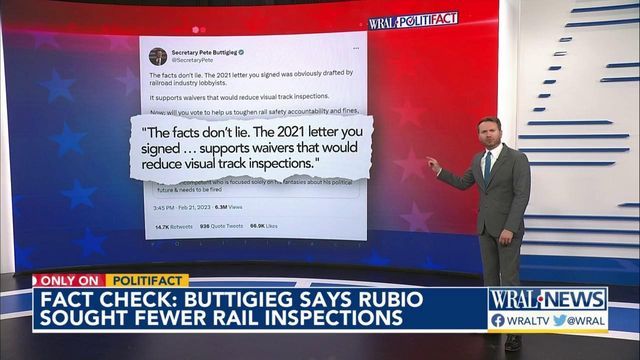Fact check: Buttigieg says GOP sought to reduce visual railway inspections
In a Feb. 21 Twitter exchange, Sen. Marco Rubio, R-Fla., and U.S. Transportation Secretary Pete Buttigieg traded barbs about a little-known track inspection rule. PolitiFact checks Buttigieg's tweet.
Posted — UpdatedLawmakers are scrutinizing railroad safety regulations following the Feb. 3 derailment of a Norfolk Southern freight train carrying hazardous chemicals.
In a Feb. 21 Twitter exchange, Sen. Marco Rubio, R-Fla., and U.S. Transportation Secretary Pete Buttigieg traded barbs about a little-known track inspection rule.
"First @SecretaryPete was m.i.a. on the derailment," Rubio wrote. "Then he lies to media claiming my 2021 letter calling for more track inspections was a letter calling for deregulation."
Rubio added that Buttigieg should resign, echoing his sentiment shared with President Joe Biden in a Feb. 16 letter.
Buttigieg replied: "The facts don’t lie. The 2021 letter you signed was obviously drafted by railroad industry lobbyists. It supports waivers that would reduce visual track inspections."
Are the facts as clear cut as Buttigieg claimed? Not exactly.
Freight railroads are owned by private companies, which are responsible for their maintenance and improvement, according to the U.S. Department of Transportation.
In October 2021, Rubio and other Republican senators signed a letter encouraging the department’s Federal Railroad Administration to review in a timely manner the railroad industry’s requests for automated track inspection test programs and waivers.
If the requests were approved, companies could have been allowed to perform fewer visual inspections. Some visual inspections could have been replaced with automated inspections that can detect some — but not all — track defects faster than human inspectors.
How railroad track inspections are done
Federal rules require that railroad companies complete a fixed number of visual track inspections. The required number and frequency of inspections depends on the railroad type.
For visual inspections, inspectors either walk the tracks, looking for defects, or travel along the tracks slowly in trucks equipped with special gear.
During automated inspections, cameras and sensors that can be attached to rail cars or locomotives inspect the tracks for defects as the car moves across them. The collected data is transmitted to employees, who schedule necessary maintenance.
In recent years, the Federal Railroad Administration has permitted some companies that operate freight railroads to participate in test programs using the automated track inspection technology. Those programs allowed for more automated track inspections and fewer visual inspections.
Rubio’s 2021 letter did not explicitly call for fewer visual inspections
The department spokesperson said the letter supported industry requests to waive visual track inspections in favor of automated inspections.
The letter encouraged the Federal Railroad Administration to continue the use of automated track inspection technology by responding more quickly to the railroad insutry’s test program and waiver requests. It argued that the agency had allowed the test programs to expire despite their "proven track record of success."
A Rubio spokesperson said the senators raised concerns about the agency’s process in the letter, but did not advocate for a specific outcome.
"Please indicate what next steps FRA is considering to further enable use of this safety technology," the letter said. "If FRA seeks additional supporting data, please indicate when the Safety Board will return to its long practice of timely reviewing waiver and test program requests to allow the nation’s rail industry to advance."
The letter did not explicitly advocate for fewer visual track inspections.
Automated inspections vs. visual inspections
Railroad experts told PolitiFact there are pros and cons to both visual and automated track inspections and that prioritizing safety would involve combining both approaches.
"There are certain things that the machine can do a lot better and a lot faster than a human," said Steve Ditmeyer, who served as the Federal Railroad Administration’s head of research and development during the Clinton and Bush administrations.
For example, automated track inspection technology can sometimes assess track geometry — the surface, alignment and gauge of the tracks — more easily and reliably than human inspectors, Ditmeyer said.
But the technology has limitations.
Jeff Joines is the national legislative director of the Brotherhood of Maintenance of Way Employes Division/Teamster Rail Conference, a union for workers who maintain railroad tracks. He said that the Federal Railroad Administration lists 23 track defects that can cause derailments; automated track inspection technology inspects for six of them, he said.
Using both inspection types — automated and visual — can ensure track safety, Joines said. The Department of Transportation told PolitiFact that automated inspections offer safety benefits as long as they don’t come at the expense of human inspection.
The department and Joines both noted that railroad companies already are allowed to run automated track inspection technology as often as they wish, even without Federal Railroad Administration approval.
Through the waiver requests, the railroad companies asked the government for permission to do fewer visual inspections.
PolitiFact ruling
Buttigieg said Rubio signed a 2021 letter that "supports waivers that would reduce visual track inspections."
Rubio’s 2021 letter encouraged the Federal Railroad Administration to quickly review the railroad industry’s requests for automated track inspection test programs and waivers.
Buttigieg’s claim leaves out important information.
The letter did not explicitly advocate for fewer visual track inspections. If the agency had approved the railroad industry’s requests, fewer visual track inspections would have been required. But the reduction in visual inspections would have been supplemented with automated track inspections.
Buttigieg’s statement contains an element of truth but ignores critical facts that would give a different impression. We rate it Mostly False.
Copyright 2024 Politifact. All rights reserved.





